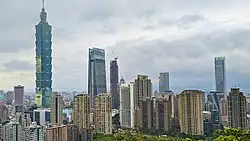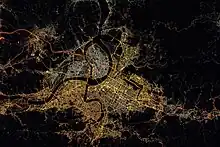Taipei–Keelung metropolitan area
The Taipei–Keelung metropolitan area (Chinese: 臺北基隆都會區; pinyin: Táiběi-Jīlóng Dūhùiqū) also commonly known as Greater Taipei Area (Chinese: 大臺北地區; pinyin: Dà Táiběi Dìqū) is the largest metropolitan area in Taiwan. It is composed of 3 administrative divisions: Taipei, New Taipei City and Keelung. The region encompasses an area of 2,457.13 square kilometers (948.70 sq mi) and a population of 7,034,084 as of 2019. It is the most populous and the most densely populated metropolitan area in Taiwan, with one-third of Taiwanese people living and working there. In some sources Taoyuan City is occasionally considered as part of the metropolitan area on a broader extent, or as an adjacent metropolitan area of its own.
Taipei–Keelung metropolitan area | |
|---|---|
 Taipei skyline | |
.svg.png.webp) | |
| Coordinates: 25°2′N 121°38′E | |
| Country | Taiwan
|
| Primary administrative divisions | Taipei |
| Area | |
| • Metro | 2,457.13 km2 (874.59 sq mi) |
| Population (End of January 2019) | |
| • Metro | 7,034,084 |
| • Metro density | 2,862.7/km2 (8,042.7/sq mi) |
The region is the epicenter of Taiwanese culture, economy, education and government. Designated as a global city, the region exerts a significant impact on commerce, finance, media, art, fashion, research, technology, education, and entertainment, both locally and internationally. As a diplomatic center, it is the home to all consulates and embassies in Taiwan. Its economic power makes the region the country's premier commercial and financial center as well as in the region of East Asia. Considered to be a global city and rated as an Alpha - City by GaWC,[1] Taipei is part of a major high-tech industrial area.[2] Railways, highways, airports, and bus lines connect Taipei with all parts of the island. The metropolitan area is served by two airports – Songshan and Taoyuan.
Definition
| Division name | Population (31 January 2019)[3] | Area (km²) | Density (per km²) |
|---|---|---|---|
| Taipei City | 2,666,908 | 271.80 | 9,812.0 |
| New Taipei City | 3,997,189 | 2,052.57 | 1,947.4 |
| Keelung City | 369,987 | 132.76 | 2,786.9 |
| Taipei–Keelung metropolitan area | 7,034,084 | 2,457.13 | 2,862.7 |
| Taoyuan City | 2,223,733 | 1,220.95 | 1,821.3 |
| Taipei–Keelung–Taoyuan metropolitan area | 9,257,817 | 3,678.08 | 2,517.0 |
Some international reports consider Taipei–Keelung–Taoyuan (臺北基隆桃園都會區; Táiběi–Jīlóng–Táoyuán Dūhùiqū) as a real complete metropolitan area.[3][4][5]
Geography

Due to the geographical characteristics of the area, the Taipei–Keelung metropolitan area roughly corresponds to areas located within the Taipei Basin. Taipei City serves as the core of the metropolitan area where the government of Taiwan and major commercial districts are located.
Geographical Subdivision
The metropolitan area contains Taipei City, Keelung City, and New Taipei City (surrounding the two previous cities). The geographical subdivisions are listed as follows:
|
Northwest
in New Taipei City: |
North
in New Taipei City: in Taipei City: |
East
in Keelung City: in Taipei City: in New Taipei City: |
|
Center
in Taipei City: | ||
|
Southwest
in New Taipei City: | ||
|
South
in Taipei City: in New Taipei City: |
GDP
2014 Taipei–Keelung metropolitan area's GDP per capita(PPP) was US$46,102.[6]
Transportation
Rail

The Taipei–Keelung metropolitan area is served by routes of the Taiwan Railway Administration (Western Trunk line, Yilan line, Pingxi line, Shen'ao line) and Taiwan High Speed Rail which connect the area with all parts of the island.
Mass Rapid Transit
For rapid transit, Taipei and New Taipei are served by the Taipei Metro with daily trips of over 2 million passengers. And only Danhai light rail is operated by New Taipei Metro. Also Taoyuan Airport MRT connects Taipei City, New Taipei City, and Taoyuan City with Taoyuan International Airport.
Air
The area is served by Taiwan Taoyuan International Airport for international flights while Songshan Airport is primarily for domestic flights, international flights to Tokyo and Seoul; and also cross-strait flights.
Bus
An extensive bus system serves the metropolitan area.
See also
- Administrative divisions of Taiwan
- Geography of Taiwan
- List of metropolitan areas in Asia by population
- List of Taiwanese counties and cities by area
- List of Taiwanese counties and cities by population
- List of Taiwanese counties and cities by population density
- Political divisions of Taiwan (1895-1945)
References
- "The World According to GaWC 2020". GaWC - Research Network. Globalization and World Cities. Retrieved 21 November 2020.
- "Taiwan tech industry faces up to South Korea's Samsung". The Seattle Times. April 2013. Archived from the original on 25 August 2017. Retrieved 25 August 2017.
- 鄉鎮市區人口及按都會區統計. Taiwan Ministry of Interior. 2013.
- World: metropolitan areas Archived 2007-09-30 at the Wayback Machine World Gazetteer, 2010
- Taipei: largest cities and towns and statistics of their population World Gazetteer, 2010
- "Global Metro Monitor". 30 November 2001.